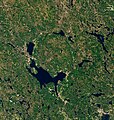File:Sweden's Siljan Ring.jpeg

Size of this preview: 570 × 599 pixels. Other resolutions: 228 × 240 pixels | 457 × 480 pixels | 731 × 768 pixels | 974 × 1,024 pixels | 1,948 × 2,048 pixels | 3,808 × 4,003 pixels.
Original file (3,808 × 4,003 pixels, file size: 4.65 MB, MIME type: image/jpeg)
File history
Click on a date/time to view the file as it appeared at that time.
| Date/Time | Thumbnail | Dimensions | User | Comment | |
|---|---|---|---|---|---|
| current | 04:24, 16 November 2022 |  | 3,808 × 4,003 (4.65 MB) | StellarHalo | {{Information |Description=Covered with lakes, forests, and mountains, Dalarna County has been called “Sweden in miniature.” But the same region that today draws people to its idyllic lakeside villages and midsummer celebrations was also the site of an ancient, catastrophic impact. Around 380 million years ago, in the Late Devonian period, an asteroid slammed into the land that is now south-central Sweden. The impact left quite a mark. Even after hundreds of millions of years of erosion, the... |
File usage
The following pages on the English Wikipedia use this file (pages on other projects are not listed):
Global file usage
The following other wikis use this file:
- Usage on fr.wikipedia.org
- Usage on gl.wikipedia.org


